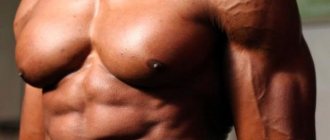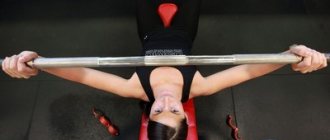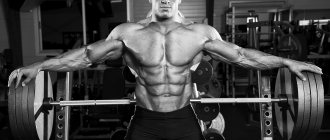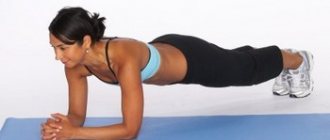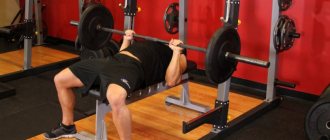“Often women ignore working on the pectoral muscles, believing that they don’t need to pump anything,” the trainer shares his experience Arthur Belous, two-time absolute Champion of Arnold Classic Australia, athlete of the Beast Genetics company, champion of EVLS PRAGUE PRO 2016, international master of sports WRPF, WPC, WPA, AWPC, IPL/RPL, GPO, GPC, multiple and absolute champion of the World, Europe, Eurasia. — Other ladies worry that by pumping up these muscles too much, they will lose their feminine breast shape. In fact, the right approach to exercise will help make a woman even more attractive, add elasticity to her contours, and add youth to her adult body.
Let us remind you that the pectoral group includes the pectoralis major and minor muscles. The larger one is conventionally divided into upper, central and lower parts: the central one works in all exercises, the upper and lower ones need additional ones.
Reason to pump up your pectoral muscles #1: improved posture
For good posture, exercises are usually done on the back and shoulders. Meanwhile, the pectoral muscles are an antagonist to the muscles of the upper back. Without well-developed and elastic chest muscles, correct position of the shoulder blades is impossible.
A typical pose for a modern woman is hunched over a computer or with a smartphone. In this forward-bent position, the pectoral muscles are shortened and lose tone. With weakened and short pectoral muscles, the shoulder blades easily move into an anatomically incorrect position. Hence the familiar stoop: the neck and shoulders are tilted forward and down, the shoulder blades are turned and protrude.
Effective exercises: bench press or dumbbell bench press, push-ups with your palms slightly wider than your body.
Dropping wrists
When performing the bench press, do not let your wrists bend back; the bar should be in the same plane as your forearms. By allowing your wrists to drop, you create the conditions for medical problems to arise, and the working weight in this position of the hands is not in line with the points of maximum application of force.
Need an illustration? Keep your wrists clenched tightly, as if you were hitting a punching bag.
The bar should be in the same plane as your forearms.
https://youtu.be/yqjMppaP7ms
Reason to pump up the pectoral muscles No. 2: improving the functioning of the respiratory muscles
The pectoral muscles themselves, of course, do not participate in the act of breathing. “The diaphragm is primarily responsible for this,” explains Arthur Belous, “to improve the respiratory mechanism, you need to master the technique of diaphragmatic and lower thoracic breathing. Such exercises are especially beneficial for people with chronic obstructive pulmonary disease and chronic respiratory failure.” At the same time, by returning the normal length to the pectoral muscles, removing the stoop, in which the ribs compress the lungs, you will literally expand the chest. Particular attention should be paid to the pectoralis minor muscle, which is attached to the middle of the third, fourth and fifth ribs and should stretch when inhaling so as not to interfere with the expansion of the ribs.
Effective exercises: lying dumbbell flyes, pullovers, push-ups on extensions or parallel bars (when the chest drops below the palms).
#4 Lack of arching in the lower back
Error
A flat back during bench presses is not a critical mistake, but it can still reduce the effectiveness of the exercise. The deflection in the lower back allows you to better expand the pecs outward, which causes them to stretch at the lowest point . Moreover, in this position it is easier to control the weight, so experienced bodybuilders often deliberately increase the arch in the lower back.
Solution
During bench presses, only the buttocks, shoulder blades and the back of the head should be in contact with the bench. 1-2 centimeters between the lower back and the bench .
When performing heavy bench presses, arching your lower back may pose a risk of back injury. To prevent this from happening, we recommend increasing the load gradually and not taking too much weight. To be on the safe side, you can take a weightlifting belt , which will reduce the likelihood of injury and stabilize the body during exercise.
Reason to pump up the pectoral muscles No. 3: bust enlargement
Of course, the volume of the mammary glands themselves cannot be changed with exercise. “Training the pectoral muscles is useful for women because it helps lift the breasts and make them more expressive,” says Arthur Belous. “It is recommended to additionally work the upper part of the pectoralis major muscle to lift the breasts and improve their shape.”
With proper training, the lower part of the pectoral muscle will perform the task of a push-up bra. But with exercises on the central part of the chest you should be more careful. If you overdo it, breast fat tissue will begin to “burn” and you can get the opposite effect. This area is best trained in low repetition mode.
Effective exercises: barbell and dumbbell presses on an incline bench, push-ups from a low bar.
#3 Incorrect position of the shoulder blades
Error
Often, during bench presses, all attention is directed to the correct position of the elbows and wrists, and many simply forget about the back muscles. However, the position of the back plays a key role in distributing the load to the pecs. The shoulder blades are especially important: if you don’t bring them together during presses, you will transfer the load from your pecs to your shoulders .
It all happens as follows. If the shoulder blades do not come together, this is immediately reflected in the pectoral blades, which stop arching forward. An insufficiently arched chest during bench presses leads to a series of consequences: the trajectory of the movement increases, and the bar and forearms travel more distance per repetition. At the lowest point, a significant part of the load falls on your shoulders and you risk “breaking” them when working with heavy weight.
Solution
How to do a bench press with a barbell correctly so that your shoulders say “thank you” to you? Even before starting the presses, make sure that your shoulder blades are brought together . Imagine that there is a pencil sandwiched between them. Try to keep your shoulder blades in this position throughout the entire set of barbell presses. At the top point, the position of the shoulder blades should not change even though it is quite difficult to keep them retracted.
Throughout the entire exercise, your pecs should be convex like lenses. Don't worry that this will shorten the trajectory. The price is only a couple of centimeters, but your shoulders will be reliably protected from overloads.
Reason to pump up the pectoral muscles No. 4: expanding everyday possibilities
A woman’s physical activity is not limited to training: she needs to open a heavy door, lift a fallen child, bring bags of groceries home... Almost everything we do or lift with our hands involves the pectoral muscles to one degree or another. When they are weak and untrained - and in everyday life they exercise little - any carrying, lifting, opening, etc. are more difficult. That's why if your pecs are weak, even simply carrying and loading bags into the elevator can feel like a challenge.
Effective exercises: any, both dynamic (presses, push-ups) and static (squeezing palms, etc.)
Common bench press mistakes
The bench press is one of the most popular exercises in bodybuilding. Being basic, it involves several muscle groups: pectoral, triceps, anterior deltoids, latissimus. The main and target muscles, naturally, are the pectoral muscles, sometimes the triceps (close-grip press), but the pectoral muscles are still strongly included in the work. In general, every athlete knows that in order to form a voluminous chest, you need to bench press. And in this article we will look at the most common mistakes in the bench press.
Incorrect grip width The width of the grip determines which muscles the load will be shifted to: if you take the barbell too narrowly, the triceps and anterior deltoids will be more involved; Accordingly, the wider the grip, the more the pecs will be included in the work. Beginning athletes often complain that when pressing, for some reason, their shoulders become more clogged than their chest - so, this is due to a too narrow grip. If you don’t feel the pecs working, just try taking the bar wider. For an optimal grip, your forearms should generally be parallel to the floors and perpendicular to each other.
Wrist position
Do not allow your wrists to bend - they should not fall back. This position of the wrists, under the weight of the barbell, is fraught with injury; so try to align them. If that doesn’t work, it’s better to take a lighter weight.
Too much weight
There is no need to stroke your ego and lift weights that you cannot handle - this will not end well. If you understand that, objectively, the weight of the barbell is too much for you, then it is better to reduce it. Sometimes it turns out that beginners hang up a bunch of weights and start squirming under the bar, and it turns out that it’s not they who are doing the lifting, but the spotter who is doing the lifting. Do not overestimate yourself - this is fraught with injury.
Neglecting the negative phase
Do not lower the bar too quickly, because it is in the negative phase that the muscles are stretched and receive microtrauma, which serves as a catalyst for their growth. Therefore, always keep the lowering process under control - do not throw the barbell, but lower it smoothly.
Partial amplitude
Any exercise in bodybuilding, if it is designed to increase muscle mass, must be performed in full amplitude, otherwise the muscles are not stretched enough and this is biochemically unfavorable.
Body position
You should position yourself on the bench so that your eyes are directly under the bar - this is the optimal position from which it is convenient to grab the barbell and, when performing the exercise, it will not touch the racks.
The shoulder blades should be brought together as much as possible. In fact, you should only lie on them and your buttocks.
Foot placement
Your legs should be fully planted and tucked as far underneath you as possible. This will provide you with a stable position and the ability to do an explosive bridge press if you are not already extending.
#10 Legs “dance”
Error
Many people, while doing a bench press, have their legs twitch as if they were being attacked by a maniac strangler. As a result, the position of the body becomes unstable : there is a risk of falling off the bench along with the weight and “earning” a trip to the nearest hospital.
Another mistake could be incorrect placement of the feet: they are too narrow to the bench, in front of or behind the knees. In all of these cases, the support of the legs does not provide stability to the core, which makes performing presses more difficult and risky.
Solution
How to do a bench press with a barbell correctly in terms of leg position? Before you start the exercise, check your feet. Ideally, they should be exactly under the knees - only in this position will the body be in a secure position throughout the entire set of exercises. Also, your feet should not point perpendicular to the bench. Your toes should point in the same direction as your knees.
Some athletes use the technique of placing their feet on a bench: this option is only suitable for advanced athletes and is associated with a high risk of losing balance and ending up on the floor with the barbell.
#5 Incorrect grip
Error
One of the most serious mistakes that can cost you your health. It consists in taking the bar with a monkey grip , when all the fingers are on one side (photo on the left). It would seem that this position of the fingers seems justified: the bar is as close as possible to the lower part of the palm above the radius. This technique helps you cope with bench presses easier and even lift more weight. However, there is one “but” that covers all these advantages.
When the fingers are on one side, there is a risk of the bar falling off . This happens so quickly that even a dozen backups cannot save you. The bar may fall on your chest or throat, causing internal bleeding or simply suffocating you. It is for this reason that using a monkey grip for bench presses is often called a suicide grip , and you can only use it after making a will.
Solution
Take the barbell so that your thumb and the other four fingers are on opposite sides of the bar. Squeeze the bar tightly so that it does not move around in your palm. This way you will have complete control over the weight and protect yourself from the bar falling.
Try to hold the barbell so that the bar is closer to the bottom of your palm (photo on the right). This technique will help to avoid bending in the wrists when the working weight is too heavy.
#8 Weight set incorrectly
Error
Sometimes athletes set the same weight on both sides of the bar, but the layout of the plates on each side is different . For example, on the right there are pancakes of 5, 10 and 15 kg, and on the left there are 2 pancakes of 15 kg each. It would seem that the weight on the right and left is balanced, but everything is not so simple. Due to the different set of plates, the center of gravity of the bar shifts. The load will be distributed unevenly, and performing presses will be much more difficult.
Solution
Try to hang the weights on the bar symmetrically so that the center of gravity of the bar is strictly in the center. The pancakes must be the same in weight and size and be securely fastened with locks.
#6 Lack of safety net
Error
One of the most critical mistakes during bench presses is the lack of a spotter who can come to the rescue during a failure repetition. Without a safety net, the barbell can easily land on your chest, neck, or head. It can all end in intensive care, as in the case of the monkey grip.
Solution
To be on the safe side, you can use special racks that will prevent the barbell from falling during a failure repetition. Ideally, the racks should be wide enough so that the bar cannot miss them - this also happens.
two horizontal benches instead . If they are too low or high, then you definitely need a belayer. Ask anyone in the room to help, tell them how many repetitions you are going to do and which of them you think might be a failure. Choose your belayer carefully so that it doesn’t turn out to be a kid who will land on you along with the barbell in case of failure.
Have you decided to perform bench presses without racks and a spotter? Here are some tips on what you can do in an emergency:
- The surest way to avoid unpleasant consequences is to quickly call someone for help . Compared to the no-lock press or belly roll technique, this is the safest way to avoid injury.
- Try to press without locks on the bar . In case of an emergency, tilt one part of the bar so that the plates fall to the floor. After this, you can repeat the same with the other side of the brief. When dropping weights, try to hold the bar very tightly, as it can fly upward like a catapult.
- If you press with locks, if it is impossible to squeeze the bar, you need to carefully lower it onto your chest and try to roll it down to your lower abdomen , tensing your abs. Once this happens, slide your body towards the counter. The bar should be on your hips. Calmly lift your torso and transfer the barbell from your hips to the bench. Roll the bar closer to the rack and place the bar on it using a deadlift.
